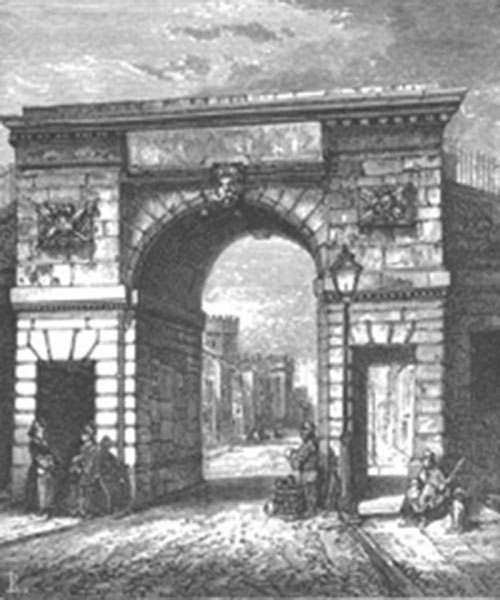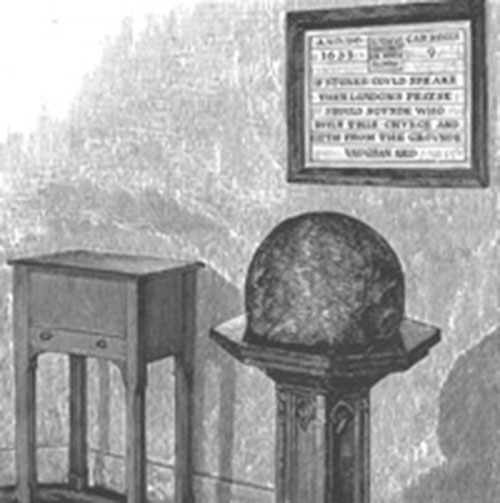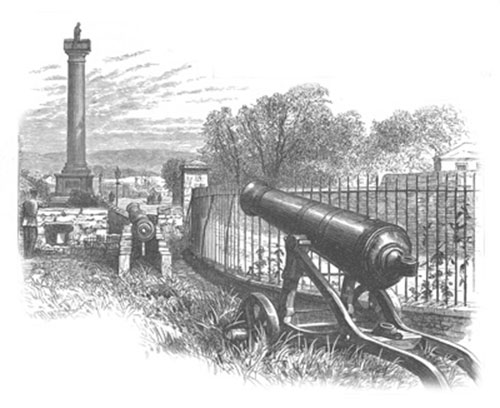Derry History - Irish Pictures (1888)
From Irish Pictures Drawn with Pen and Pencil(1888) by Richard Lovett
Chapter IX: Belfast, Armagh, and Londonderry … concluded
« Previous Page | Start of Chapter | Book Contents | Next Chapter »
The name Derry is an epitome of its history. It is the anglicised form of the Irish word doire or daire, meaning an oak-wood. It enters into an immense number of Irish names, and wherever it occurs indicates that once an oak forest flourished there. The pagan name was Daire-Calgaich, the oak-wood of Calgach. In 546 Columba founded his monastery here; for centuries the old name held its ground, but about the tenth century it was replaced by Derry-Columb-Kille. This remained the name until the reign of James I., when the change of ownership resulted in the change of name into Londonderry.[1]
As already noted, Columba was born at Gartan, a wild Donegal district, in 521. He spent much of his boyhood at a place called Temple Douglas, at Kilmacrenan. According to the Annals of Ulster, he founded the church at Derry when he was only twenty-five. No trace of the original building, which was known as the Black Church, survives. 'Its Round Tower was standing in the seventeenth century, but the only record of its existence now remaining is the name of the lane which leads to its site, the Long Steeple.'[2]
Londonderry practically dates from the Plantation of Ulster. The county was held in early times by the O'Cathans, or O'Kanes, who were tributary to the O'Neils. Upon the overthrow of that powerful sept, and the confiscation of their estates in 1609, Derry, Coleraine, and the adjacent territory were awarded to the citizens of London, sixty out of every thousand acres being reserved for the Church, and some portions being given to three native Irish gentlemen. The Common Council of London agreed to spend £20,000 upon the district, appointed twenty-six men to manage it, and called them the Irish Society, kept for itself Derry and Coleraine, and parted the rest of the land amongst twelve of the London Livery Companies. In 1637 their charter was cancelled; Cromwell restored the Society, and Charles II. granted a new charter. Over 150,000 acres are thus held by the Irish Society and the Companies, among the latter the chief proprietors being the Skinners, 34,000, the Drapers 27,000, the Mercers 21,000, and the Fishmongers 20,000.
London soon began those works which have fastened its name upon Derry. In 1609 the walls were built at a cost of over £8,000. They are still perfect, and now form a pleasant promenade about a mile in extent. There are six gates. These walls are associated with the famous siege, and upon them stand the lofty monument to the Rev. George Walker and the old gun known as Roaring Meg. Into the story of the siege of 1689, which lasted 105 days, of the sufferings endured by the garrison, of their heroism, and of the final battle at the Vorn which raised the siege, we have no space to enter in detail. For popular purposes Macaulay's account is perhaps sufficient; those who wish to make a special study of it cannot do better than consult Dr. Witherow's Derry and Enniskillen in 1689.
The Cathedral of Derry owes its existence to London. It dates from 1633, and in the porch, which also contains a bombshell fired into the town during the siege, stands a tablet which runs:
If stones could speak, then London's praise should sound,
Who built this church and city from the ground.
The building consists of a nave and two aisles separated from each other by pointed arches. It has been recently enlarged by the addition of a choir. Over the entrance is a large organ with very finely-carved wood, said to have been taken from one of the Armada wrecks. A large tower surmounted by a spire stands at the western end of the cathedral. From the top of the tower a splendid view is obtained. The whole city lies at the observer's feet, enabling him to recognise readily all the important buildings and sites, and to watch the various signs of commercial activity. At the same time he commands on every side a wide prospect over the pretty surrounding country.
A very extensive shirt manufacture is carried on in Derry, not the weaving process, but the making up of all kinds of shirts. The factories are very large, and employ a considerable number of hands, a very large proportion being women and girls. A visit to one of them introduces the stranger to many processes of interest. The ingenious knives for cutting out large quantities of collars, cuffs, &c, at a time, the minute subdivision of labour, the enormous number of sewing machines, and its general air of rapid work and prosperous trade have a stimulating effect, after a journey through the wilds of Donegal or Connemara.
END OF CHAPTER IX.
NOTES
[1] See Irish Names of Places (Joyce), pp. 503, 504.
[2] Reeves' edition of Adamnan's Life of Columba, p. 277.
« Previous Page | Start of Chapter | Book Contents | Next Chapter »



